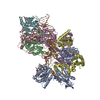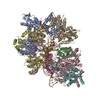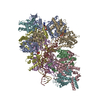[English] 日本語
 Yorodumi
Yorodumi- PDB-7tjj: S. cerevisiae ORC bound to 84 bp ARS1 DNA and Cdc6 (state 1) with... -
+ Open data
Open data
- Basic information
Basic information
| Entry | Database: PDB / ID: 7tjj | ||||||||||||
|---|---|---|---|---|---|---|---|---|---|---|---|---|---|
| Title | S. cerevisiae ORC bound to 84 bp ARS1 DNA and Cdc6 (state 1) with docked Orc6 N-terminal domain | ||||||||||||
 Components Components |
| ||||||||||||
 Keywords Keywords | REPLICATION/DNA / initiator / helicase loader / AAA+ ATPase / REPLICATION-DNA complex | ||||||||||||
| Function / homology |  Function and homology information Function and homology informationCDC6 association with the ORC:origin complex / Cul8-RING ubiquitin ligase complex / maintenance of rDNA / Assembly of the ORC complex at the origin of replication / nuclear origin of replication recognition complex / pre-replicative complex assembly involved in nuclear cell cycle DNA replication / Activation of the pre-replicative complex / nuclear pre-replicative complex / Activation of ATR in response to replication stress / DNA replication preinitiation complex ...CDC6 association with the ORC:origin complex / Cul8-RING ubiquitin ligase complex / maintenance of rDNA / Assembly of the ORC complex at the origin of replication / nuclear origin of replication recognition complex / pre-replicative complex assembly involved in nuclear cell cycle DNA replication / Activation of the pre-replicative complex / nuclear pre-replicative complex / Activation of ATR in response to replication stress / DNA replication preinitiation complex / mitotic DNA replication checkpoint signaling / silent mating-type cassette heterochromatin formation / regulation of DNA-templated DNA replication initiation / CDK-mediated phosphorylation and removal of Cdc6 / Orc1 removal from chromatin / regulation of DNA replication / DNA replication origin binding / subtelomeric heterochromatin formation / DNA replication initiation / nucleosome binding / G1/S transition of mitotic cell cycle / chromosome / chromosome, telomeric region / cell division / GTPase activity / chromatin binding / GTP binding / ATP hydrolysis activity / nucleoplasm / ATP binding / nucleus / metal ion binding / cytoplasm Similarity search - Function | ||||||||||||
| Biological species |  | ||||||||||||
| Method | ELECTRON MICROSCOPY / single particle reconstruction / cryo EM / Resolution: 2.7 Å | ||||||||||||
 Authors Authors | Schmidt, J.M. / Yang, R. / Kumar, A. / Hunker, O. / Bleichert, F. | ||||||||||||
| Funding support |  United States, 3items United States, 3items
| ||||||||||||
 Citation Citation |  Journal: Nat Commun / Year: 2022 Journal: Nat Commun / Year: 2022Title: A mechanism of origin licensing control through autoinhibition of S. cerevisiae ORC·DNA·Cdc6. Authors: Jan Marten Schmidt / Ran Yang / Ashish Kumar / Olivia Hunker / Jan Seebacher / Franziska Bleichert /   Abstract: The coordinated action of multiple replicative helicase loading factors is needed for the licensing of replication origins prior to DNA replication. Binding of the Origin Recognition Complex (ORC) to ...The coordinated action of multiple replicative helicase loading factors is needed for the licensing of replication origins prior to DNA replication. Binding of the Origin Recognition Complex (ORC) to DNA initiates the ATP-dependent recruitment of Cdc6, Cdt1 and Mcm2-7 loading, but the structural details for timely ATPase site regulation and for how loading can be impeded by inhibitory signals, such as cyclin-dependent kinase phosphorylation, are unknown. Using cryo-electron microscopy, we have determined several structures of S. cerevisiae ORC·DNA·Cdc6 intermediates at 2.5-2.7 Å resolution. These structures reveal distinct ring conformations of the initiator·co-loader assembly and inactive ATPase site configurations for ORC and Cdc6. The Orc6 N-terminal domain laterally engages the ORC·Cdc6 ring in a manner that is incompatible with productive Mcm2-7 docking, while deletion of this Orc6 region alleviates the CDK-mediated inhibition of Mcm7 recruitment. Our findings support a model in which Orc6 promotes the assembly of an autoinhibited ORC·DNA·Cdc6 intermediate to block origin licensing in response to CDK phosphorylation and to avert DNA re-replication. | ||||||||||||
| History |
|
- Structure visualization
Structure visualization
| Structure viewer | Molecule:  Molmil Molmil Jmol/JSmol Jmol/JSmol |
|---|
- Downloads & links
Downloads & links
- Download
Download
| PDBx/mmCIF format |  7tjj.cif.gz 7tjj.cif.gz | 589 KB | Display |  PDBx/mmCIF format PDBx/mmCIF format |
|---|---|---|---|---|
| PDB format |  pdb7tjj.ent.gz pdb7tjj.ent.gz | 452.4 KB | Display |  PDB format PDB format |
| PDBx/mmJSON format |  7tjj.json.gz 7tjj.json.gz | Tree view |  PDBx/mmJSON format PDBx/mmJSON format | |
| Others |  Other downloads Other downloads |
-Validation report
| Summary document |  7tjj_validation.pdf.gz 7tjj_validation.pdf.gz | 1.7 MB | Display |  wwPDB validaton report wwPDB validaton report |
|---|---|---|---|---|
| Full document |  7tjj_full_validation.pdf.gz 7tjj_full_validation.pdf.gz | 1.7 MB | Display | |
| Data in XML |  7tjj_validation.xml.gz 7tjj_validation.xml.gz | 84 KB | Display | |
| Data in CIF |  7tjj_validation.cif.gz 7tjj_validation.cif.gz | 129.4 KB | Display | |
| Arichive directory |  https://data.pdbj.org/pub/pdb/validation_reports/tj/7tjj https://data.pdbj.org/pub/pdb/validation_reports/tj/7tjj ftp://data.pdbj.org/pub/pdb/validation_reports/tj/7tjj ftp://data.pdbj.org/pub/pdb/validation_reports/tj/7tjj | HTTPS FTP |
-Related structure data
| Related structure data |  25927MC  7tjfC  7tjhC  7tjiC  7tjkC C: citing same article ( M: map data used to model this data |
|---|---|
| Similar structure data | Similarity search - Function & homology  F&H Search F&H Search |
- Links
Links
- Assembly
Assembly
| Deposited unit | 
|
|---|---|
| 1 |
|
- Components
Components
-Origin recognition complex subunit ... , 6 types, 6 molecules ABCDEF
| #1: Protein | Mass: 104818.422 Da / Num. of mol.: 1 Source method: isolated from a genetically manipulated source Source: (gene. exp.)  Gene: ORC1, YML065W / Production host:  Trichoplusia ni (cabbage looper) / References: UniProt: P54784 Trichoplusia ni (cabbage looper) / References: UniProt: P54784 |
|---|---|
| #2: Protein | Mass: 71342.180 Da / Num. of mol.: 1 Source method: isolated from a genetically manipulated source Source: (gene. exp.)  Gene: ORC2 / Production host:  Trichoplusia ni (cabbage looper) / References: UniProt: P32833 Trichoplusia ni (cabbage looper) / References: UniProt: P32833 |
| #3: Protein | Mass: 72161.766 Da / Num. of mol.: 1 Source method: isolated from a genetically manipulated source Source: (gene. exp.)  Gene: ORC / Production host:  Trichoplusia ni (cabbage looper) / References: UniProt: P54790 Trichoplusia ni (cabbage looper) / References: UniProt: P54790 |
| #4: Protein | Mass: 61044.414 Da / Num. of mol.: 1 Source method: isolated from a genetically manipulated source Source: (gene. exp.)  Gene: ORC4, YPR162C, P9325.5 / Production host:  Trichoplusia ni (cabbage looper) / References: UniProt: P54791 Trichoplusia ni (cabbage looper) / References: UniProt: P54791 |
| #5: Protein | Mass: 55347.168 Da / Num. of mol.: 1 Source method: isolated from a genetically manipulated source Source: (gene. exp.)  Gene: ORC5, YNL261W, N0834 / Production host:  Trichoplusia ni (cabbage looper) / References: UniProt: P50874 Trichoplusia ni (cabbage looper) / References: UniProt: P50874 |
| #6: Protein | Mass: 50369.531 Da / Num. of mol.: 1 Source method: isolated from a genetically manipulated source Source: (gene. exp.)  Gene: ORC6, AAP1, YHR118C / Production host:  Trichoplusia ni (cabbage looper) / References: UniProt: P38826 Trichoplusia ni (cabbage looper) / References: UniProt: P38826 |
-DNA chain , 2 types, 2 molecules GH
| #7: DNA chain | Mass: 25820.561 Da / Num. of mol.: 1 / Source method: obtained synthetically / Source: (synth.)  |
|---|---|
| #8: DNA chain | Mass: 25977.766 Da / Num. of mol.: 1 / Source method: obtained synthetically / Source: (synth.)  |
-Protein , 1 types, 1 molecules I
| #9: Protein | Mass: 58384.625 Da / Num. of mol.: 1 Source method: isolated from a genetically manipulated source Source: (gene. exp.)  Gene: CDC6, YJL194W, J0347 / Production host:  Trichoplusia ni (cabbage looper) / References: UniProt: P09119 Trichoplusia ni (cabbage looper) / References: UniProt: P09119 |
|---|
-Non-polymers , 3 types, 168 molecules 




| #10: Chemical | ChemComp-ATP / #11: Chemical | ChemComp-MG / #12: Water | ChemComp-HOH / | |
|---|
-Details
| Has ligand of interest | Y |
|---|
-Experimental details
-Experiment
| Experiment | Method: ELECTRON MICROSCOPY |
|---|---|
| EM experiment | Aggregation state: PARTICLE / 3D reconstruction method: single particle reconstruction |
- Sample preparation
Sample preparation
| Component | Name: ORC in complex with ARS1 DNA and Cdc6 / Type: COMPLEX / Entity ID: #1-#9 / Source: MULTIPLE SOURCES |
|---|---|
| Molecular weight | Experimental value: NO |
| Buffer solution | pH: 7.6 |
| Specimen | Embedding applied: NO / Shadowing applied: NO / Staining applied: NO / Vitrification applied: YES |
| Specimen support | Grid material: GOLD / Grid mesh size: 300 divisions/in. / Grid type: Quantifoil R1.2/1.3 |
| Vitrification | Cryogen name: ETHANE |
- Electron microscopy imaging
Electron microscopy imaging
| Experimental equipment |  Model: Titan Krios / Image courtesy: FEI Company |
|---|---|
| Microscopy | Model: FEI TITAN KRIOS |
| Electron gun | Electron source:  FIELD EMISSION GUN / Accelerating voltage: 300 kV / Illumination mode: OTHER FIELD EMISSION GUN / Accelerating voltage: 300 kV / Illumination mode: OTHER |
| Electron lens | Mode: BRIGHT FIELD / Nominal defocus max: 1600 nm / Nominal defocus min: 800 nm |
| Image recording | Electron dose: 6.6 e/Å2 / Film or detector model: GATAN K2 SUMMIT (4k x 4k) |
- Processing
Processing
| Software | Name: PHENIX / Version: 1.19.2_4158: / Classification: refinement | ||||||||||||||||||||||||
|---|---|---|---|---|---|---|---|---|---|---|---|---|---|---|---|---|---|---|---|---|---|---|---|---|---|
| CTF correction | Type: PHASE FLIPPING AND AMPLITUDE CORRECTION | ||||||||||||||||||||||||
| Symmetry | Point symmetry: C1 (asymmetric) | ||||||||||||||||||||||||
| 3D reconstruction | Resolution: 2.7 Å / Resolution method: FSC 0.143 CUT-OFF / Num. of particles: 88859 / Symmetry type: POINT | ||||||||||||||||||||||||
| Refine LS restraints |
|
 Movie
Movie Controller
Controller






 PDBj
PDBj











































